初中英语语法---状语从句小结
状语从句归纳总结
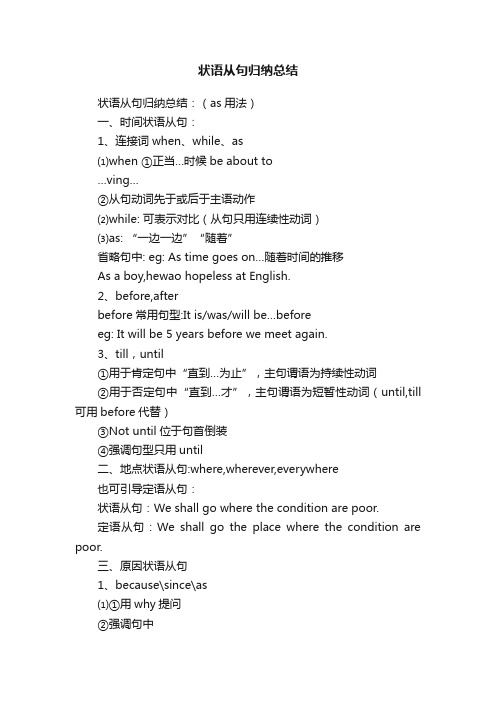
状语从句归纳总结状语从句归纳总结:(as用法)一、时间状语从句:1、连接词when、while、as⑴when ①正当…时候be about to…ving…②从句动词先于或后于主语动作⑵while: 可表示对比(从句只用连续性动词)⑶as: “一边一边”“随着”省略句中: eg: As time goes on…随着时间的推移As a boy,hewao hopeless at English.2、before,afterbefore常用句型:It is/was/will be…beforeeg: It will be 5 years before we meet again.3、till,until①用于肯定句中“直到…为止”,主句谓语为持续性动词②用于否定句中“直到…才”,主句谓语为短暂性动词(until,till 可用before代替)③Not until位于句首倒装④强调句型只用until二、地点状语从句:where,wherever,everywhere也可引导定语从句:状语从句:We shall go where the condition are poor.定语从句:We shall go the place where the condition are poor.三、原因状语从句1、because\since\as⑴①用why提问②强调句中③关联词“not…but”④与“just”等副词连用eg:You shouldn’t any only because you had much.⑵since引导从句常放句首,往往表示对方已知的让步原因关系,主从时态一般相同⑶as从句放句首2、now(that) 既然3、considering that,seeing (that):与since,now that意相近: “鉴于…”“考虑到…”4、not that…,but that…“不是因为…而是因为…”四、目的状语从句1、that,so that,in order that“为了,以便”⑴从句中往往出现情态动词:can\could\may\might⑵当主从句的主语一致时,可转换为相应动词不定式结构:so as to\in order to2、in case,for fear that,lest“以防、以免、万一..”从句是肯定句五、结果状语从句1、so,that,so thatso that可以引导结果状语从句和目的状语从句,区别在于:目的状从中有情动(结果状从前有“,”号)2、so…thatsuch a\an +形+单名=so+形+a\an+单名“如此…以至于”3、such…thatsuch…that(状从)such…as(定从)4、such that (是这样…以致)六、条件状语从句:主句中用一般将来时,从句中用一般现在时或一般过去时1、if正面条件“如果”2、unless. 反面条件=if not 主句为否定意味,从句为肯定句(从句也可用否定结构)unless做介词“除非,如果不”3、so\as long as,on condition that “条件是…”“只要..”4、in case既可引导目的状,又可引导条件状=”if it happened that…”5、providing,provided that, suppsing,suppose (that),given (that) “如果,只要,假如”七、方式状语从句1、as,just as“如…”“正如…一样”Do just as you like2、as if, as though (虚拟语气)八、比较状语从句1、as…as,the same as. 否定句用not so\as…as,not the same as从句中常用省略句: eg:He runs as fast as he can.2、than3、the more…the more…“越…越…”4、more than九、让步状语从句1、although,though.句中不出现but,可出现still\yet(副词)though的位置较灵活,可倒装2、even if,even though“即使”even if表主观,时态往往用于将来even though通常表客观上的,往往表过去事实3、no matter wh…只用于让步状语从句wh..ever 让步状从/名词性从句4、as特殊倒状5、while,whereas突出对比6、if(=even if) 强调部分(n.\adj.\adv.\v.) +as+主+谓(可以是情动)。
初中英语状语从句知识点总结归纳

初中英语状语从句知识点总结归纳在初中英语中,状语从句是一种复杂的句子结构,它用于描述主句的动作发生的时间、条件、原因、结果、地点等。
以下是关于初中英语状语从句知识点总结归纳:一、状语从句的定义:状语从句是用来修饰主句中的动词、形容词或副词,表示时间、地点、原因、条件、结果等关系的从句。
二、状语从句的分类:根据引导词的不同,状语从句可以分为以下几类:1. 时间状语从句:由when, while, as, before, after, since, until等引导。
2. 地点状语从句:由where, wherever, everywhere等引导。
3. 原因状语从句:由because, since, as等引导。
4. 条件状语从句:由if, unless, as long as等引导。
5. 结果状语从句:由so that, so...that, such...that等引导。
三、状语从句的用法:1. 时间状语从句:表示动作发生的时间或持续的时间。
例如:When I was young,I often played football.(当我还小的时候,我经常踢足球。
)2. 地点状语从句:表示动作发生的地点。
例如:Wherever you go, I will followyou.(无论你去哪里,我都会跟着你。
)3. 原因状语从句:表示动作发生的原因。
例如:As it was raining, we had to stay indoors.(因为下雨了,我们不得不呆在室内。
)4. 条件状语从句:表示动作发生的条件。
例如:If it snows tomorrow, we will not go out.(如果明天下雪,我们就不出去了。
)5. 结果状语从句:表示动作发生的结果。
例如:She worked hard so that she could pass the exam.(她努力学习以便能通过考试。
状语从句知识点大总结

状语从句知识点大总结一、状语从句的定义状语从句是一个句子,它在句子中作状语,修饰主句中的动词、形容词、副词等,用以表示时间、条件、原因、目的、结果、比较等不同的状态。
状语从句通常由连词引导,常用的连词包括when, while, as, since, before, after, until, if, unless, although, though, as if, as though, so that, in order that, in case, even if等。
二、状语从句的分类1. 时间状语从句时间状语从句表示动作发生的时间,常用的引导词有when, while, as, before, after, since, until, as soon as等。
例如:- When I was young, I used to go swimming every day.- I will call you as soon as I arrive.2. 条件状语从句条件状语从句表示条件,常用的引导词有if, unless, provided that, as long as等。
例如:- If it rains tomorrow, we will stay at home.- I will go out unless it is raining.3. 原因状语从句原因状语从句表示原因,常用的引导词有because, since, as, for等。
例如:- Since it is raining, we can't go out.- I won't go to the party because I don't feel well.4. 目的状语从句目的状语从句表示目的,常用的引导词有so that, in order that, lest等。
例如:- I study hard so that I can get a good job.- We left early in order that we might avoid the traffic.5. 结果状语从句结果状语从句表示结果,常用的引导词有so...that, such...that等。
初中状语从句知识点总结
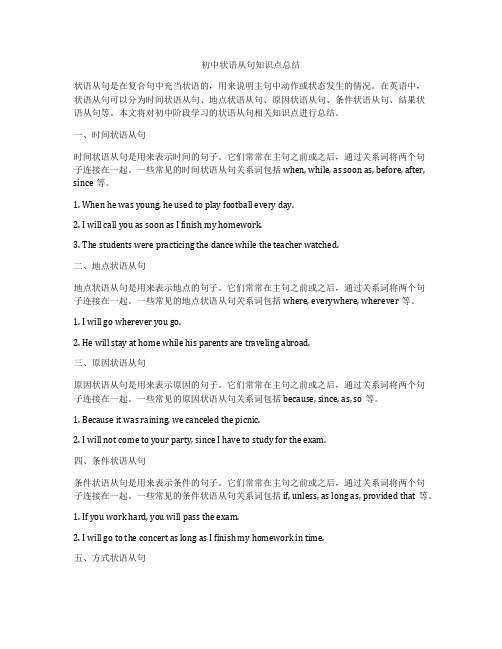
初中状语从句知识点总结状语从句是在复合句中充当状语的,用来说明主句中动作或状态发生的情况。
在英语中,状语从句可以分为时间状语从句、地点状语从句、原因状语从句、条件状语从句、结果状语从句等。
本文将对初中阶段学习的状语从句相关知识点进行总结。
一、时间状语从句时间状语从句是用来表示时间的句子。
它们常常在主句之前或之后,通过关系词将两个句子连接在一起。
一些常见的时间状语从句关系词包括when, while, as soon as, before, after, since等。
1. When he was young, he used to play football every day.2. I will call you as soon as I finish my homework.3. The students were practicing the dance while the teacher watched.二、地点状语从句地点状语从句是用来表示地点的句子。
它们常常在主句之前或之后,通过关系词将两个句子连接在一起。
一些常见的地点状语从句关系词包括where, everywhere, wherever等。
1. I will go wherever you go.2. He will stay at home while his parents are traveling abroad.三、原因状语从句原因状语从句是用来表示原因的句子。
它们常常在主句之前或之后,通过关系词将两个句子连接在一起。
一些常见的原因状语从句关系词包括because, since, as, so等。
1. Because it was raining, we canceled the picnic.2. I will not come to your party, since I have to study for the exam.四、条件状语从句条件状语从句是用来表示条件的句子。
初中英语知识点归纳状语从句的分类和用法

初中英语知识点归纳状语从句的分类和用法状语从句是英语语法中重要的一部分,它用来修饰主句的动作或描述情况的,在句子中起着状语的作用。
状语从句分为时间状语从句、条件状语从句、原因状语从句、目的状语从句、结果状语从句、方式状语从句和比较状语从句等。
下面将对初中英语中常见的状语从句分类和用法进行归纳。
一、时间状语从句时间状语从句用来表示动作或事件发生的时间,包括连词when (当...时候),while (在...时候),before (在...之前),after (在...之后),as (当),since (自从),until (直到)等。
时间状语从句一般放在主句之前或者之后。
例如:- When I was young, I used to play soccer with my friends. (当我年轻的时候,我常常和朋友们踢足球。
)- After she finished her homework, she went to bed. (她完成作业之后,去睡觉了。
)二、条件状语从句条件状语从句用来表示主句动作的条件或前提,包括连词if (如果),unless (除非),in case (以防),as long as (只要),provided/providing (只要)等。
条件状语从句一般放在主句之前。
例如:- If it rains tomorrow, we will stay at home. (如果明天下雨,我们就在家呆着。
)- Unless you work hard, you won't pass the exam. (除非你努力学习,否则你就不能通过考试。
)三、原因状语从句原因状语从句用来表示主句动作或情况的原因,包括连词because (因为),as (因为),since (因为),for (因为),now that (既然)等。
原因状语从句一般放在主句之前。
例如:- Because it was raining, we stayed at home. (因为下雨,我们呆在家里。
初中英语状语从句知识点总结
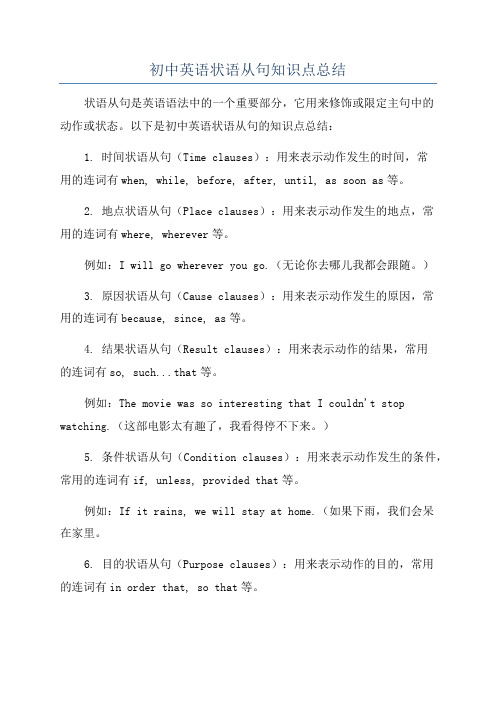
初中英语状语从句知识点总结状语从句是英语语法中的一个重要部分,它用来修饰或限定主句中的动作或状态。
以下是初中英语状语从句的知识点总结:1. 时间状语从句(Time clauses):用来表示动作发生的时间,常用的连词有when, while, before, after, until, as soon as等。
2. 地点状语从句(Place clauses):用来表示动作发生的地点,常用的连词有where, wherever等。
例如:I will go wherever you go.(无论你去哪儿我都会跟随。
)3. 原因状语从句(Cause clauses):用来表示动作发生的原因,常用的连词有because, since, as等。
4. 结果状语从句(Result clauses):用来表示动作的结果,常用的连词有so, such...that等。
例如:The movie was so interesting that I couldn't stop watching.(这部电影太有趣了,我看得停不下来。
)5. 条件状语从句(Condition clauses):用来表示动作发生的条件,常用的连词有if, unless, provided that等。
例如:If it rains, we will stay at home.(如果下雨,我们会呆在家里。
6. 目的状语从句(Purpose clauses):用来表示动作的目的,常用的连词有in order that, so that等。
例如:I bought a new notebook so that I can take notes in class.(我买了一个新笔记本,这样我可以在课堂上记笔记。
)7. 方式状语从句(Manner clauses):用来表示动作发生的方式,常用的连词有as, as if, as though等。
例如:He speaks as if he knows everything.(他说话的样子就像他什么都知道。
状语从句的用法归纳总结
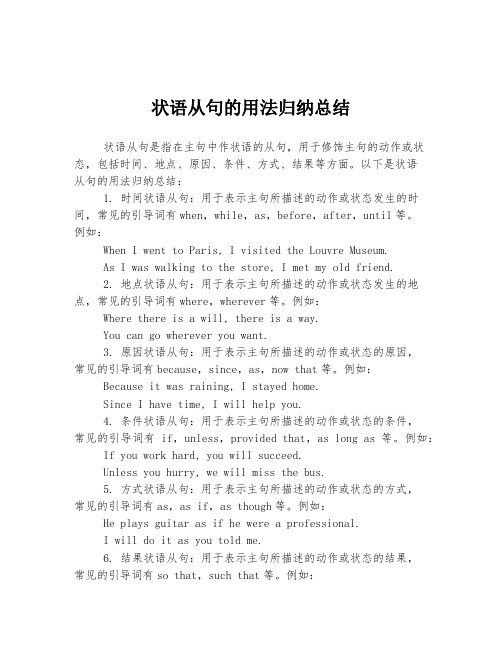
状语从句的用法归纳总结状语从句是指在主句中作状语的从句,用于修饰主句的动作或状态,包括时间、地点、原因、条件、方式、结果等方面。
以下是状语从句的用法归纳总结:1. 时间状语从句:用于表示主句所描述的动作或状态发生的时间,常见的引导词有when,while,as,before,after,until等。
例如:When I went to Paris, I visited the Louvre Museum.As I was walking to the store, I met my old friend.2. 地点状语从句:用于表示主句所描述的动作或状态发生的地点,常见的引导词有where,wherever等。
例如:Where there is a will, there is a way.You can go wherever you want.3. 原因状语从句:用于表示主句所描述的动作或状态的原因,常见的引导词有because,since,as,now that等。
例如:Because it was raining, I stayed home.Since I have time, I will help you.4. 条件状语从句:用于表示主句所描述的动作或状态的条件,常见的引导词有if,unless,provided that,as long as等。
例如:If you work hard, you will succeed.Unless you hurry, we will miss the bus.5. 方式状语从句:用于表示主句所描述的动作或状态的方式,常见的引导词有as,as if,as though等。
例如:He plays guitar as if he were a professional.I will do it as you told me.6. 结果状语从句:用于表示主句所描述的动作或状态的结果,常见的引导词有so that,such that等。
状语从句知识点总结
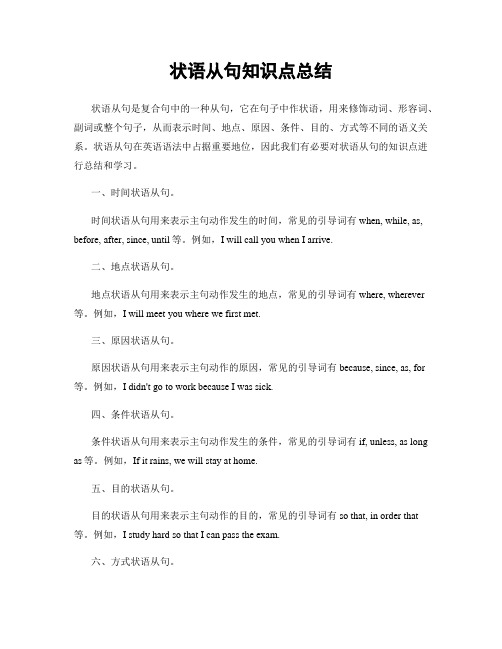
状语从句知识点总结状语从句是复合句中的一种从句,它在句子中作状语,用来修饰动词、形容词、副词或整个句子,从而表示时间、地点、原因、条件、目的、方式等不同的语义关系。
状语从句在英语语法中占据重要地位,因此我们有必要对状语从句的知识点进行总结和学习。
一、时间状语从句。
时间状语从句用来表示主句动作发生的时间,常见的引导词有when, while, as, before, after, since, until等。
例如,I will call you when I arrive.二、地点状语从句。
地点状语从句用来表示主句动作发生的地点,常见的引导词有where, wherever 等。
例如,I will meet you where we first met.三、原因状语从句。
原因状语从句用来表示主句动作的原因,常见的引导词有because, since, as, for 等。
例如,I didn't go to work because I was sick.四、条件状语从句。
条件状语从句用来表示主句动作发生的条件,常见的引导词有if, unless, as long as等。
例如,If it rains, we will stay at home.五、目的状语从句。
目的状语从句用来表示主句动作的目的,常见的引导词有so that, in order that 等。
例如,I study hard so that I can pass the exam.六、方式状语从句。
方式状语从句用来表示主句动作的方式,常见的引导词有as, as if, as though等。
例如,He speaks as if he were a native speaker.七、让步状语从句。
让步状语从句用来表示与主句动作相反的情况,常见的引导词有though, although, even though, while, whereas等。
状语从句用法总结计划完整

一、时间状语从句时间状语从句用来表示时间关系,常由连词“当……时候”、“随着”、“一旦”、“随时”、“直到”、“自从”等引导。
例如:1.当我在家里的时候,我妈妈总是在旁边看着我。
2.随着天气的转暖,我们就可以去郊游了。
3.一旦你有了问题,就可以找我帮忙。
4.随时都可以来找我,我随时都在。
5.直到你完成这个任务,我才会离开。
6.自从我来到这个城市,我就没有回过家。
二、地点状语从句地点状语从句用来表示地点关系,常由连词“在……地方”、“位于”、“从……起”、“直至”等引导。
例如:1.在这个超市里,你可以找到各种各样的商品。
2.位于市中心的位置,使得这个商场非常繁华。
3.从这家公司起,我们的合作就一直非常好。
4.直至你找到工作,你就可以安心了。
三、原因状语从句原因状语从句用来表示原因关系,常由连词“因为”、“由于”、“鉴于”等引导。
例如:1.因为我今天不舒服,所以我不想去上课。
2.由于天气的原因,我们取消了郊游计划。
3.鉴于你的表现,老师给了你很高的评价。
四、条件状语从句条件状语从句用来表示条件关系,常由连词“如果”、“只要”、“除非”、“只要……就”等引导。
例如:1.如果明天不下雨,我们就去郊游。
2.只要你能努力,你一定能成功。
3.除非你道歉,否则我不会原谅你。
4.只要你想明白,你就会知道我为什么这样做。
五、目的状语从句目的状语从句用来表示目的关系,常由连词“为了”、“以便”、“好”等引导。
例如:1.为了能更好地学习,他每天都很努力。
2.以便你能理解,我解释得很详细。
3.好让你明白,我特意给你举个例子。
六、结果状语从句结果状语从句用来表示结果关系,常由连词“所以”、“因此”、“结果”、“从而”等引导。
例如:1.所以他没能来,因为他生病了。
2.因此我们决定,明天再去郊游。
3.结果这个方法很有效,我们很快就完成了任务。
4.从而使我们的工作更加顺利。
一、时间状语从句时间状语从句用来表示时间关系,常由连词“当……时候”、“随着”、“一旦”、“随时”、“直到”、“自从”等引导。
初中英语语法---状语从句小结
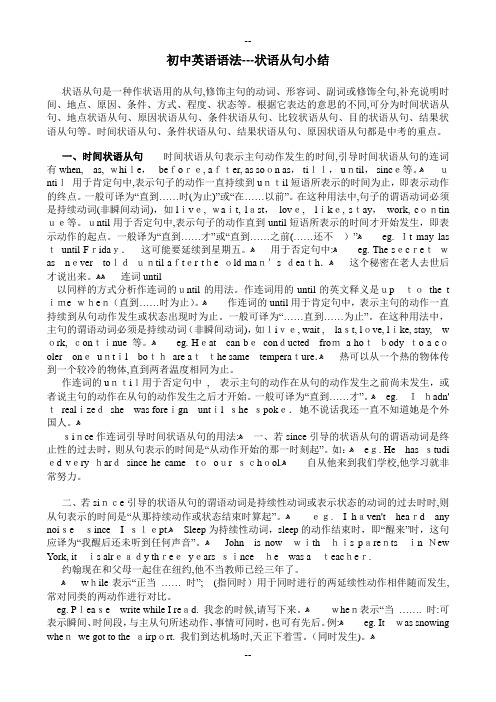
初中英语语法---状语从句小结状语从句是一种作状语用的从句,修饰主句的动词、形容词、副词或修饰全句,补充说明时间、地点、原因、条件、方式、程度、状态等。
根据它表达的意思的不同,可分为时间状语从句、地点状语从句、原因状语从句、条件状语从句、比较状语从句、目的状语从句、结果状语从句等。
时间状语从句、条件状语从句、结果状语从句、原因状语从句都是中考的重点。
一、时间状语从句时间状语从句表示主句动作发生的时间,引导时间状语从句的连词有when,as, while,before, after, as soon as,till,until,since等。
ﻫuntil用于肯定句中,表示句子的动作一直持续到until短语所表示的时间为止,即表示动作的终点。
一般可译为“直到……时(为止)”或“在……以前”。
在这种用法中,句子的谓语动词必须是持续动词(非瞬间动词),如live, wait, last,love,like, stay,work, contin ue等。
until用于否定句中,表示句子的动作直到until短语所表示的时间才开始发生,即表示动作的起点。
一般译为“直到……才”或“直到……之前(……还不)”ﻫeg. It may las tuntil Friday.这可能要延续到星期五。
ﻫ用于否定句中:ﻫeg. The secretwas never tolduntil after the old man's death.ﻫ这个秘密在老人去世后才说出来。
ﻫﻫ连词until以同样的方式分析作连词的until的用法。
作连词用的until的英文释义是uptothe t ime when(直到……时为止)。
ﻫ作连词的until用于肯定句中,表示主句的动作一直持续到从句动作发生或状态出现时为止。
一般可译为“……直到……为止”。
在这种用法中,主句的谓语动词必须是持续动词(非瞬间动词),如live, wait ,last, love, like, stay,w ork, continue 等。
状语从句知识点总结
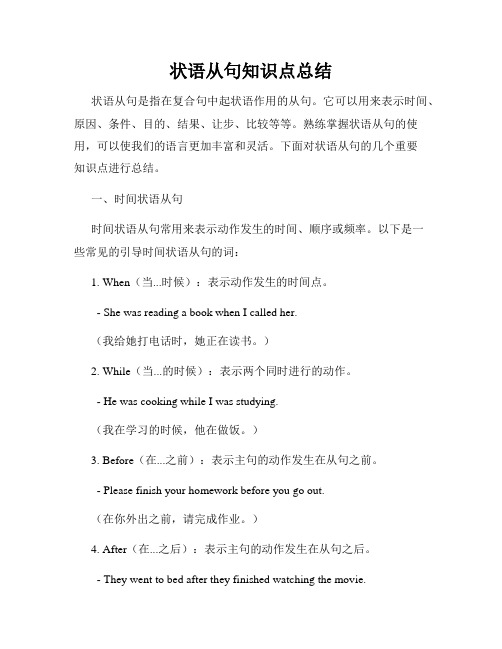
状语从句知识点总结状语从句是指在复合句中起状语作用的从句。
它可以用来表示时间、原因、条件、目的、结果、让步、比较等等。
熟练掌握状语从句的使用,可以使我们的语言更加丰富和灵活。
下面对状语从句的几个重要知识点进行总结。
一、时间状语从句时间状语从句常用来表示动作发生的时间、顺序或频率。
以下是一些常见的引导时间状语从句的词:1. When(当...时候):表示动作发生的时间点。
- She was reading a book when I called her.(我给她打电话时,她正在读书。
)2. While(当...的时候):表示两个同时进行的动作。
- He was cooking while I was studying.(我在学习的时候,他在做饭。
)3. Before(在...之前):表示主句的动作发生在从句之前。
- Please finish your homework before you go out.(在你外出之前,请完成作业。
)4. After(在...之后):表示主句的动作发生在从句之后。
- They went to bed after they finished watching the movie.(他们在看完电影之后就去睡觉了。
)二、原因状语从句原因状语从句常用来表示某个动作的原因或理由。
以下是一些常见的引导原因状语从句的词:1. Because(因为):表示直接的原因。
- I didn't go to the party because I was tired.(我因为累所以没有参加聚会。
)2. Since(因为):表示已知的事实或理由。
- He was absent from work since he was not feeling well.(他因病缺勤了。
)3. As(因为):表示两个动作同时发生,前者是后者发生的原因。
- I couldn't hear the speaker as the music was too loud.(由于音乐声音太大,我听不到演讲者的声音。
状语从句知识点总结
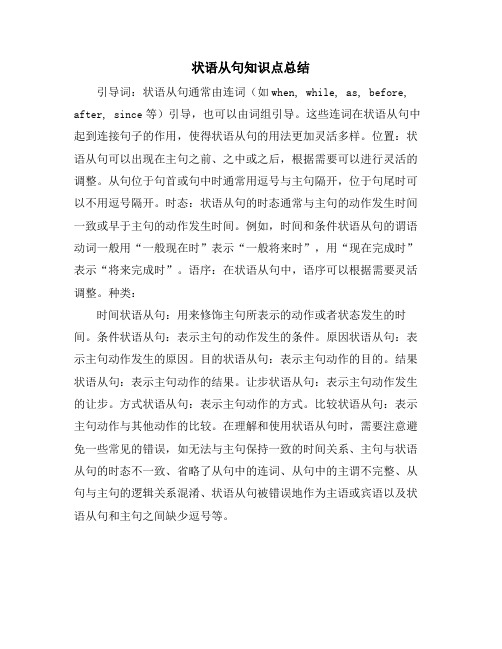
状语从句知识点总结
引导词:状语从句通常由连词(如when, while, as, before, after, since等)引导,也可以由词组引导。
这些连词在状语从句中起到连接句子的作用,使得状语从句的用法更加灵活多样。
位置:状语从句可以出现在主句之前、之中或之后,根据需要可以进行灵活的调整。
从句位于句首或句中时通常用逗号与主句隔开,位于句尾时可以不用逗号隔开。
时态:状语从句的时态通常与主句的动作发生时间一致或早于主句的动作发生时间。
例如,时间和条件状语从句的谓语动词一般用“一般现在时”表示“一般将来时”,用“现在完成时”表示“将来完成时”。
语序:在状语从句中,语序可以根据需要灵活调整。
种类:
时间状语从句:用来修饰主句所表示的动作或者状态发生的时间。
条件状语从句:表示主句的动作发生的条件。
原因状语从句:表示主句动作发生的原因。
目的状语从句:表示主句动作的目的。
结果状语从句:表示主句动作的结果。
让步状语从句:表示主句动作发生的让步。
方式状语从句:表示主句动作的方式。
比较状语从句:表示主句动作与其他动作的比较。
在理解和使用状语从句时,需要注意避免一些常见的错误,如无法与主句保持一致的时间关系、主句与状语从句的时态不一致、省略了从句中的连词、从句中的主谓不完整、从句与主句的逻辑关系混淆、状语从句被错误地作为主语或宾语以及状语从句和主句之间缺少逗号等。
总之,状语从句的使用可以丰富句子的结构,使文章更加丰富多样。
掌握状语从句的引导词、位置、时态、语序以及种类等知识点,对于提高英语写作能力具有重要意义。
初中英语九种状语从句归纳总结
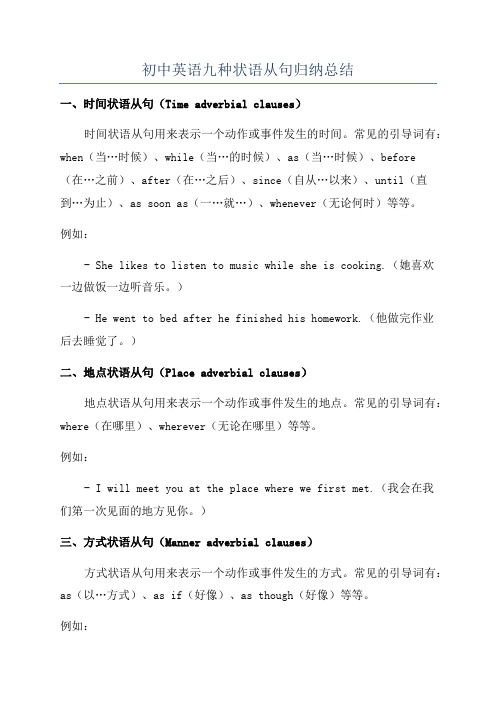
初中英语九种状语从句归纳总结一、时间状语从句(Time adverbial clauses)时间状语从句用来表示一个动作或事件发生的时间。
常见的引导词有:when(当…时候)、while(当…的时候)、as(当…时候)、before (在…之前)、after(在…之后)、since(自从…以来)、until(直到…为止)、as soon as(一…就…)、whenever(无论何时)等等。
例如:- She likes to listen to music while she is cooking.(她喜欢一边做饭一边听音乐。
)- He went to bed after he finished his homework.(他做完作业后去睡觉了。
)二、地点状语从句(Place adverbial clauses)地点状语从句用来表示一个动作或事件发生的地点。
常见的引导词有:where(在哪里)、wherever(无论在哪里)等等。
例如:- I will meet you at the place where we first met.(我会在我们第一次见面的地方见你。
)三、方式状语从句(Manner adverbial clauses)方式状语从句用来表示一个动作或事件发生的方式。
常见的引导词有:as(以…方式)、as if(好像)、as though(好像)等等。
例如:- She sang the song as if she was performing on stage.(她唱歌的时候好像在舞台上表演一样。
)- He spoke English as though he was a native speaker.(他讲英语好像是母语一样。
)四、原因状语从句(Reason adverbial clauses)原因状语从句用来表示一个动作或事件发生的原因。
常见的引导词有:because(因为)、as(因为)、since(因为)、as long as(只要)等等。
状语从句知识点总结 英语
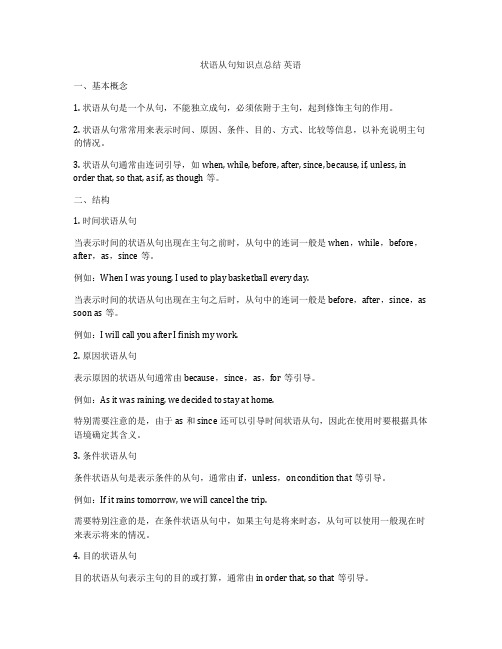
状语从句知识点总结英语一、基本概念1. 状语从句是一个从句,不能独立成句,必须依附于主句,起到修饰主句的作用。
2. 状语从句常常用来表示时间、原因、条件、目的、方式、比较等信息,以补充说明主句的情况。
3. 状语从句通常由连词引导,如when, while, before, after, since, because, if, unless, in order that, so that, as if, as though等。
二、结构1. 时间状语从句当表示时间的状语从句出现在主句之前时,从句中的连词一般是when,while,before,after,as,since等。
例如:When I was young, I used to play basketball every day.当表示时间的状语从句出现在主句之后时,从句中的连词一般是before,after,since,as soon as等。
例如:I will call you after I finish my work.2. 原因状语从句表示原因的状语从句通常由because,since,as,for等引导。
例如:As it was raining, we decided to stay at home.特别需要注意的是,由于as和since还可以引导时间状语从句,因此在使用时要根据具体语境确定其含义。
3. 条件状语从句条件状语从句是表示条件的从句,通常由if,unless,on condition that等引导。
例如:If it rains tomorrow, we will cancel the trip.需要特别注意的是,在条件状语从句中,如果主句是将来时态,从句可以使用一般现在时来表示将来的情况。
4. 目的状语从句目的状语从句表示主句的目的或打算,通常由in order that, so that等引导。
例如:We woke up early so that we could catch the first train.5. 方式状语从句方式状语从句表示主句的动作是如何完成的,通常由as if,as though,as,just as等引导。
英语语法状语从句的归纳总结

英语语法状语从句的归纳总结Ability is not the only criterion, but character is the criterion.英语语法状语从句的归纳总结在复合句中修饰主句或主句中的某一成分的从句叫状语从句..状语从句通常由从属连词或起连词作用的词组引导;有时甚至不需要连词直接和主句连接起来..状语从句根据它表达的意思不同;可分为时间、地点、原因、目的、结果、条件、方式、比较、让步等九类..一、时间状语从句时间状语从句是表示时间关系的从句..可以引导时间状语从句的连词很多;根据意义和主从句之间的时间关系;通常可分为以下几种情况:A.when; while; as; wheneverwhen; while; as表示主句谓语作和从句的谓语动作同时发生或几乎同时发生..1.when①when表示点时间时;从句中用短暂性动词;表示段时间时;用持续性动词..When I got home; my family were already having dinner.我到家的时候;全家已在吃晚饭..when表示点时间When they were still talking and laughing; the teacher came in. 当他们还在说笑的时候;老师进来了..when表示段时间He waved a hello when he saw her.当他看见她的时候;就挥手打了个招呼..when表示点时间When you think you know nothing; you begin to know something.当你认为自己一无所知的时候;就开始知道一些事情了..when表示段时间注意:当when意思是正当……时候and at that moment时;when只能跟在前一分句之后..He was about to go to bed when the doorbel rang.他正要上床;忽然门铃响了..They were watching the World Cup when suddenly the lights went out.他们正看着世界杯比赛;突然灯灭了..They had just arrived home when it began to rain.他们刚到家;天就开始下雨了..②有时when表示虽然;尽管的含义;相当于although或since..He walks when he might take a taxi.尽管可以打的;但他还是步行..How can you hope for mercy yourself when you show none既然你不宽恕别人;你自己又怎能希望得到别人的宽恕呢2.while①while通常表示一段时间;从句中宜用持续性动词作谓语..Strike while the iron is hot.趁热打铁..She fell asleep while she was reading the newspaper.她在看报的时候睡着了..②while有时可以作并列连词;表示对比;可译成……而……..I am fond of English while he likes maths.我喜欢英语而他却喜欢数学..We slept while the captain kept watch.我们睡觉而上尉担任警戒..③while有时可引导让步状语从句;意思是虽然..While they love te children; they are strict with them.虽然他们都爱他们的孩子;但却对他们要求严格..提示:虽然during 与 while 意思很相近;但是during是介词;不能引导从句.. 3.as①as表示点时间时;从句中用短暂性动词;表示段时间时;用持续性动词..as和when两者经常可以通用..The thief was caught as when he was stealing in thesupermarket.小偷在超市行窃时被逮住了..I saw Jim as when he left the meeting room.吉姆离开会议室时候我看到了他..②as表示一边……一边……;强调从句和主句中两个动作交替进行或同步进行..They talked as they walked.他们边走边聊..He looked behind from time to time as he went.他一边走;一边不时地往后看..③as表示随着As time goes on; it's getting warmer and warmer.随着时间的推移;天气变得越来越暖了..As spring warms the earth; al flowers begin to bloom.随着春回大地;百花开始绽放..4.when; while; as的用法区别①只有当从句表示的是段时间;即其谓语动词有持续性特征时;这三者可以通用互换..I got the news on the radio when while as I was having breakfast.我在吃早饭的时候从收音机里获悉这一消息..②在下列情况下;三者彼此之间不能替换使用:a.as更强调同一时间或紧接的一前一后或伴随着的变化..We listened to the singer sing as he played the guitar.我们听着歌星边弹吉它边演唱..I thought of it just as you opened your mouth.你一张嘴我就知道你要说什幺As he grew older; he became less and less active随着他年龄的增长;他变得越来越不活泼了..提示:状语从句可放在主句之前或之后;放在主句之前时一般用逗号与主句分开..有时可置于主句中间;前后用逗号..b.when更强调特定时间;还可表示从句中的动作先于或后于主句的动作..When I had given Mary the spare ticket; I found my own already gone.当我把多余的票给了玛丽时;我才发现我自己的票已不知去向..从句动作发生在主句之前;注意主从句的时态When I finally got there; he meeting had been on for ten minutes.当我最终赶到那里时;会议已开始十分钟了..从句动作发生在主句之后;注意时态 c.while从句只能表示延续的动作或状态或主从句中动作的对比..She thought I was talking about her daughter; while in fact;I was talking about my daughter. 她以为我在谈论她女儿;而事实上;我在谈论我的女儿..d.若表示两个短促动作几乎同时发生时;用as场合多于when.. As he finished his speech; the audience burst into applause. 他结束讲话时;观众爆发出雷鸣般的掌声..5.whenever whenever是when的强势语;它描述的不是一次性动作;而是经常发生的习惯性动作..You are always welcome whenever you come.无论你何时来都欢迎..Whenever we met with diffiulties; they came to help us.每当我们遇上困难的时候;他们就来帮我们..B. before; after1.beforebefore表示在一段时间之前..I must finish all the work before go home.回家之前我必须干完所有的活..You must first learn to walk before you try to run.在想要跑以前;你得先学会走..He had learned English for three years before he went to London.他去伦敦之前已学了三年英语..提示:before 从句往往带有否定的含义..He ran off before I could stop him.我还没来得及阻止他;他就跑掉了..Take it down berore you forget it.趁着还没忘记的时候就记录下来..必背: before 常用句型 It is was will be beforeIt wil be five years before we meet again.五年以后我们才能再见..It will be not long before you regret what you have done.不用过多久你就会对你所作所为感到后悔的..It was not long before I realized I was wrong.不久我就意识到我错了..It was minutes before the police arrived.过了几分钟警察才到..2.afterafter表在一段时间之后..Let's play football after school is over.放学后我们踢足球吧..The sun came out soon after the storm stopped.暴风雨过后不久;太阳出来了..C.till; until1.untiltill用于肯定句时;表示直到为止;主句必须为持续性动词.. We shall wait until till he comes back.我们将一直等到他回来.. 注意它们的拼写Everything went well untiltill that accident happened.直到发生那意外之前;一切都正常..2. not untiltill表示直到才 ;主句通常要用短暂动词;这时until和till可用before代替..I didn't leave until till before she came back.直到她回来;我才离开的..Bells don't ring till until you strike them.铃不打不响..Peopl do not know the value of their health till until before they lose it. 人们直至失去了健康才知其可贵..3.当not until位于句首时;主句中的主语、谓语要使用倒装语序..Not until she stopped crying did I leave. 直到她不哭了;我才离开的..注意: until引导的从句可以放在主句之前或主句之后;但till从句一般不放在句首.. 4.在强调句型中一般只能用until;不用till.. It was not until she took off her drk glasses that Irecognized her.直到她摘下墨镜;我才认出她..D.since; ever since1.since自……以来..表示动作从过去某一点时间一直延续到说话时间为止..主句中通常为延续性动词的现在完成时;since从句中一般用短暂性动词的一般过去时..It has been just a week since we arrived here.我们到这儿刚刚一星期..Where haveyou been since I last saw you自上次我见过你之后;你去了哪里Since she was young; she has been collecting stamps.她自年轻时起就一直集邮至今..提示:有时since 从句中也可以用延续性动词;注意它的译法..Tom is now working on the farm.It's two years since he was a college student.汤姆现在农场上班;他大学毕业已有两年了..2.ever since 从那时起直至现在;此后一直..表示说话者强调主句动作或状态持续时间长;语气比since强..Ever since they got married in 1950; they have lived happily.自一九五零年结婚以来;他们一直生得很幸福..3.since还可以用作副词或介词..The big clock was damaged during the war and has been sienteversince.这只大钟在战争中损坏了;从此就一直不响了..My uncle went to Tibet in the 1950s. He has been living thereeversince.我叔叔五十年代就去了西藏;从那以后他一直生活在那里..You have made great achievements in your work since graduation. 你们自毕业以来已经在工作中取得了巨大成就..E.as soon as as soon as...可译为一……就……;用来表示主从句的动作是紧接着发生的.. He will come and see you as soon as he can.他一有空就来看你..He rushed home as soon as he got the good news.他一得到这个好消息就奔回家..必背:一……就……还可以用onupon doing 结构来表示..On arriving home he called up Lester. = As soon as he arrived home; he called up Lester. 他一到家就给莱斯特打电话.. F. immediately instantly directly 相当于as soon as;从句中用一般过去时态..They phoned her immediately they reached home.他一到家马上就给她打了电话..I recognized her instantly I caught a glimpse of her.我一看见她就把她认出来了..We came directly we got your telephone.我们一接到你的电话就赶来了..G.the moment; the minute; the instant; the second 这几个名词短语也可用作连词;直接引导时间状语从句;表示一…就… ..He said he'd turn on TV th moment he got home.他说他一到家就打开电视机..Tell him I need to see him the minute he arrives.告诉他;他一到我就要见他..The second the bell rang; the students rushed out of the classroom.铃一响;学生就冲出了教室..H.hardly scarcely when; no sooner than这两个短语都表示刚……就……;可以互换;主句通常用去完成时..He had no sooner started out than he felt homesick.他刚出发就想起家来..He had hardly started his speech when someone rose to refute his points.他刚开始发言;就有人站起来反驳他的论点..注意:当hardly; scarcely; no sooner 位于句子的开头时;主句须用倒装语序..Hardly had she fallen asleep when a knockat the door woke her up.她刚要睡着;忽然敲门声把她吵醒..No sooner was the frost off the ground than the work began. 地上的霜一消散;人们就开始工作了..I.once once作连词时;也相当于as soon as;但它含有的条件意味更浓;它引导的从句较短..Once you begin; you must continue.一旦开了头;你就应当继续下去..Once you see him; you will neer forget him.你一旦见过他;就不会忘了他的..J.next time; the first time; the last time; every time 等Be sure to call on us next time you come to town.下次你进城一定来看我们..He left me a good impression the first time I met him.我第一次见他时;他给我留下了好印象..Every time I see him he looks miserable.我每次见到他;他都是一付痛苦的表情..The last time I spoke to Bob; he seemed happy enough.上一次我见到他时;他看上去很开心..K.by the time by the tine 也可以引导时间状语从句;意为到时为止;主句一般要用完成时态..By the time he was fourteen; Einstein had learned advanced mathematics all byhimself.爱因斯坦到十四岁时就自学完了高等数学..从句为一般过去时;主句要用过去完成时I shall have finished my work by the time you return.在你回来之前我将会做完我的活儿..从句为一般现在时;主句要用将来完成时二、地点状语从句地点状语从句通常由where; whereverwhere的强势语和everywhere引导;是表示空间关系的状语从句..A. wherewhere 在……地方;去……地方Wuhan lies here the Yangtze and the Han River meet.武汉位于长江和汉水汇合处..Where there is a will; there is a way.有志者;事竟成..I found my books where I had left them.我的书在我原来放的地方找到了..You'd better make a mark where you have any questions.哪儿有问题;你最好在哪儿做个记号..这里where引导的从句不是定语从句注意:在地点状语从句之前;不要使用介词..误You should put the book at where it was.正You should put the book where it was.你应该把书放在原来的地方..误We should go to where we are needed most.正We should go where we are needed most.我们应该到最需要我们的地方去..B.whereverwherevr在任何……地方;无论哪里Wherever you go; you should do your work well.不论到什么地方;都要把工作做好..You may sit down wherever you like.你爱坐哪儿就坐哪儿..C.everywhereEverywhere they went; they were kindly receivd.他们每到一处都受到了友好的接待..三、原因状语从句原因状语从句是表示原因和理由的从句..引导原因状语从句的有as; because; since; now that; considering that; seeing that等.. A.becausebecause因为Because I like it; I do it.因为我喜欢;所以我才干..He couldn'thave seen me; because I was not there.他不可能见过我;因为当时我不在那儿..比较: because 和for的区别..1.for 是并列连词;只用于连接表示原因的分句;因此不能用于句首..because表示原因时;可位于句首..误For he did not obey the rules; he was punished.正Because he did not obey the rules; he was punished.由于他不遵守规章制度;他受到了处..2.for 表示的是推断解释;because强调动作发生的直接原因..It must have rained last night; for the ground is wet.昨晚肯定下雨了;因为地面是湿的..不可用because;因为地面湿不是天下雨的原因The day breaks; for the birds are singing.天亮了;因为鸟在叫..不可用because;因为鸟叫不是天亮的原因He went to bed early; because he was tired由于他累了;所以他很早就上了床..直接的理由He must be tired; for he went to bed early.他肯定累了;因为他很早就上了床..间接的推断3.在强调结构It iswas that和关联词not but 引导的原因状语从句中;宜用because..It's because he helped you that I'm prepared to help him. 正是因为他帮助过你;所以我乐意去帮助他..He decided to give up thechance of going abroad; not because he did not want to but because his wife was ill.他决定放弃出国的机会;不是因为他不想去;而是因为他妻子病了..B. since since 因为;既然..引导的从句大多置于句首;主从句的时态一般相同..Since you have no licence; you are not allowed to drive.因为你没有驾驶执照;所以不允许你开车..Since you are al here; let's try and reach a decision.既然大家都来了;咱们就设法做出一个决定吧..C.as as 由于..一般多用于句首..As she was ill; she didn't come to the party.由于病了;她没来参加晚会..As he was not well enough; I had to go without him由于他身体欠佳;我只好不带他去了..As it rained; we all stayed at home.由于下雨我们都呆在家里..C. because; since; as 的区别1.because语气最强;表达的是未知的新信息;一般置于主句之后;也可以放在主句之前;用逗号隔开..在回答why引导的特殊疑问句时;或在强调结构It iswas that 和关联词not but 引导的原因状语从句中;要用because..另外;because还常和副词just; merely等连用.. 2.since 往往表示的是已知的客观事实;或分析后的推理;引导的从句大多置于句首;主从句的时态一般相同..3.as 表示的理由最弱;只是对主句的附带说明;重点在主句..as从句通常放在主句前.. Just because he doesn't complain; you mustnot suppose that he is satisfied.你不可只因他不抱怨就以为他满足了..You shouldn't get angry only because some people speak ill of you.你不该仅仅因为有些人说了你的坏话就生气..Since you're not interested; Iwon't tell you about it.既然你不感兴趣;那我就不告诉你了..As you are unable to answer perhaps we should ask someone else. 因为你不能回答;也许我们该问一问别的人..注意: because等词不能与 so连用..误Because he was careless; so he failed in the exam.正Because he was careless; he failed in the exa.由于他粗心;所以他考试不及格..正He was careless; so he failed in the exam.由于他粗心;所以他考试不及格..E.now that now that 既然;因为..that可以省略..Now that dinner is ready; go and wash your hands.既然饭已好了;洗手去吧..Now you mention it again; I do remember.既然你又提起此事;我倒回想起来了..F.conidering that; seeing that 这两个词和since; now that意思相近;都有鉴于…事实;考虑到…. 的意思..Seeing that quite a few people were absent; we decided to put the meeting off.由于好些人都没到会;我们决定延期开会..seeing 后面的that可以省略Considering that they are just beginners; they are doing quite good job.考虑到他们才刚刚学做;他们干得算很不错的了..G.not that but that 这一结构相当于汉语的不是因为…而是因为…Not that I don't like the film; but that I have no time for it. 不是因我不喜欢看这部电影;而是因为我没有时间看..状语从句二四、目的状语从句目的状语从句是表示行为目的的从句..引导目的状语从句的主要连词有that; so;so that; so that; in order that等;从句中常常使用一些情态动词;如can; could; may; might; should等..A.that; so that;in order that表示为了;以便;一般放在主句之后..that语气较弱;用的较少;多用so that..Let's take the front seats that we may se more clearly.我们坐前排吧;这样我们可以看得更清楚些..Man does not live that he may eat; but eats that he may live. 人生存不是为了吃饭;而吃饭是为了生存..They hurried so that they might not miss the train.他们为了不误火车;才急急忙忙的..In order that everyone present might hear her clearly; she raised her voice again.为了使在场的每个人都能听清楚;她再次提高了声音..注意:当主从句的主语一致时;so that和in order that引导的目的状语从句可以转换成相对应的动词不定式结构..We got upearly so that we would arrive in time.为了能及时赶到;我们起得很早..They hurried so that they might not miss the train. → They hurried so as not to miss the train.他们为了不误火车;才急急忙忙的..Betty saved money in order that she could uy a portable computer. → Betty saved money in order to buy a portable computer.贝蒂存钱是为了买一台手提电脑..B.in case; lest; for fear that 几个短语都表示万一;惟恐;含有否定的意义..Better take more clothes in case the weather is cold.最好多带些衣服以防天气会冷..Take an umbrella in caseit rains.以防下雨;带把伞..五、结果状语从句结果状语从句是表示事态结果的从句..引导结果状语从句的连词有:that; so that; so that; such that等..结果状语从句通常置于主句之后..A.so; that; so that这三个词都可以引导结果状语从句..so that最为常用;so或that常用于口语或非正式文体中..What has happened tha you look so worried发生了什幺事;使你显得如此担心I didn't plan the work well; so thatso I didn't finish it in time.我没把工作计划好;结果没按时完成..so that从句常用逗号与主句隔开The room was packed with people; so that we couldn't get in. 房间里挤满了人;我们进不去..C. so...that so...that 如此……以致……..其引导的果状语从句有如下四种结构:1.so + 形容词副词 + that-从句The village is so small that it cannot be shown in the map. 这村子太小;所以这地图上没有..The wind was so strong that we could hardly move forward.风刮得那么大;我们简直寸步难行..2.so + 形容词 + aan + 单数名词 + that-从句It was so hot a day that tey all went swimming. 天是那么的热以致他们都去游泳了.. He made so inspiring a speech that everybody got excited.他发表了如此鼓舞人的演讲以致大家都很激动..3.so + manyfew +复数名词+ that-从句I have had so many falls that I am black and blue all over. 我摔了许多跤;以至于浑身青一块;紫一块..He has so few friend that he often feels lonely.他朋友很少;所以经常感到孤独..4.so + muchlittle +不可数名词 + that-从句I had so little money then that I couldn't even afford a used car.我当时囊中羞涩;甚至连一辆二手车都买不起..He drank so much wine last night that he felt terrible.昨晚他喝了那么多的酒;他觉得很不舒服..5.在so + 形容词副词 + that-从句结构中;如将so + 形容词副词位于句首;主谓语要倒装..So excited was he that she could not say a word.他很激动;一句话都说不出来..So loudly did he speak that even the people in the next room could hear him.他说得很响;连隔壁的人都能听见..D. such... that such...that 如此……以致……..其引导的结果语从句有如下四种结构: 1.such + aan + 形容词 + 单数可数名词 + that-从句Jenny is such a clever girl that all of us like her very much 詹妮是如此聪明的女孩;以至我们都非常喜欢她..We left in such a hurry that we forgot to lock the door.我们走得匆忙;把门都忘了锁了..2.such + 形容词 +复数名词+ that-从句He gave suchimportant reasons that he was excused.他说出了这么重要的理由;得到大家的谅解..They are such interesting novels that all of us want to read them.这些是十分有意思的小说;大家都想看..3.such + 形容词 + 不可数名词 + that-从句He made such rapid progress that the teacher praised him.他的进步很快;老师表扬了他..H shut the window with such force that the glass broke.他关窗子用了那么大的劲;玻璃都碎了..提示:such+aan+形容词+单数名词结构可以和so +形容词+aan+单数名词结构互换..He told us such a funny story that we all laughed. → He told us so funny a story that we all laughed.他给我们讲了一个如此有趣的故事;大家都笑.. →The story he told us was so funny that we all laughed. 他给我们讲的故事是如此有趣;大家都笑了..E. such that such that可以连用;意思是是这样...以致..Mother's answer was such that she didn't say yes and shedidn't say no.妈妈的回答就是这样;既没有同意也没有不同意..His anger was such that he lost control of himself. 他勃大怒;以致不能自制..比较:such ...that ... 引导的是结果状语从句.. such ...as ...引导的是定语从句请参考第10章定语从句..She had such a fright that she fainted.她吓得昏了过去..Luckily such earthquakes as can cause a lot of damage do no happen very often.很幸运;这种破坏性很大的地震并不经常发生..关系代词as在定语从句中作主语六、条件状语从句..条件状语从句是表示主句动作发生的前提或条件的从句..条件状语从句分为真实条件状语从句和非真实条件状语从句见第3章..引导条件状语从句的有if; unless; so as long as; as so far as; on condition that; in case; suppose; supposing等..条件状语从句中的谓语动词一般要用现在时或过去时代替一般将来时或过去将来时A.if if表示正面条件;意为如果..If you ask hm; he will help you.如果你向他请求;他会帮助你..Difficulties are nothing if we are not afraid of them.如果我们不怕困难;困难就算不了什么了..If I do not understand what he says; I always ask him.我不懂他的话时; 总是去问他..if = when比较: if only和only if的对比.. if only 解释但愿;要是……就好了;表示一个不可能实现愿望;要用虚拟语气.. only if 解释只有;等于only on condition that;从句用陈述语气..Only if you heat ice; it turns to water.只有当你给冰加热;它才会变成水..If only I knew要是我知道该多好..B.unless unless = if not; 表示反面条件;意思是如果不、除非.. They will go tomorrow unless it rains.除非明天下雨;否则他们会去的..They will go tomorrow if it doesn't rain.I won't let you in unless you show me your pass.如果你不出示通行证;我就不让你进来..= I won't let you in if you don't show me your pass.注意: if...not和unless通常是可以换用的..但在下列情况下;两者是有区别的:1.unless多引导真实条件句;if not可以引导真实条件句或非真实条件句..Hewon't be able to pass the final exams unless he works hard. 除非他努力;否则就通过不了期末考试..He won't be able to pass the final exams if he doesn't work hard.如果他不努力;就通过不了期末考试..He would pass the final exams if he worked hard.要是他努力的话;他就会通过考试..非真实条件句..含义是Hedoesn'twork hard.2.如果主句描述的是情感或情绪活动方面的内容;if not结构不能换成unless..如:I'll be quite glad if she doesn't come this evening.她今晚如果不来我很高兴..3.unless引导的状语从句可用否定结构;而if not引导的从句不可再用否定结构..Don't ask me to explain again unless you really don't understand.不要再叫我解释了;除非你真的不懂..4.uless能作为介词使用;相当于except;而if not不可以.. Nothing will come out of it unless disaster.这种事除非引起灾祸之外不会有什么结果..C.so long as; as long as; on condition that 这几个短语意思差不多;都表示只要;条件是……..AsSo long as we don't lose heart; we'll find a way to overcome the difficulty.只要我们灰心;我们就能找到克服困难的方法..You may use the room on condition that so long as you cleanit afterwards.只要你用完后打扫干净;你就可以使用这个房间..D.in case in case 既引导目的状语从句;也可以引导条件状语从句;等于if it happens that..In case I forget; please remind me of my promise.如果我忘了;请提醒我所做的承诺..Send s a message in case you have any difficulty.万一你有什么困难;请给我们一个信儿..E.providing; provided that; supposing; suppose that; given that 这几个短语意思相近;有如果;只要;假如等意思..Given that they are inexperienced; they've done a good job. 考虑到他们缺乏经验;他们的工作已做得很好了..that可以省略rovided Providingthatwe invite him; he would surely come to dinner.假如我们邀请他的话;他肯定会来吃饭的..SupposeSupposing we can't get enough food; what shall we do 假设我们弄不到足够的食物;那我们怎幺办仅用于疑问句七、方式状语从句方式状语从句是描述动作方式的从句..方式状语从句常由as; as if as though等词引导;通常位于主句之..A. as; just as 这两个连词的意思是如……;正如……一样..just as 比as 语气要强一些..Do in Rome as the Romans do.入乡随俗..Leave things as they are.让一切顺其自然..Please do as you are told.请按照人家告诉你做的去做..也可说Please do as told.Balloons float in the air just as boats do on the sea.气球在空中就如同船浮在海面上一样..注意:在口语中;还可用like来代替as;引导一个方式状语从句.. She is doing the work exactly like I want her to她正在完全按照我要她的那样在做这项工作..Do you make bread like you make cakes你做面包的方法是不是和做点心一样B.as if; as though 由as if 或as though引导的状语从句可以用陈述语气表示可能符合事实的情况;也可以用虚拟语气的过去式表示现在不符的或与事实相反的情况见第3章虚拟语气..She looks as if she is ill.看上去她好象是生病了..The boy plays piano as though he has a natural ear for music. 这孩子弹起钢琴来家好象天生很懂音乐似的..。
中考状语从句知识点归纳

中考状语从句知识点归纳状语从句是英语中用来修饰动词、形容词、副词或整个句子的从句,它通常由一个引导词(如when, if, because等)引导,并在句子中承担时间、地点、原因、条件、目的、结果、让步等状语成分。
中考中,状语从句的考查是英语语法的重点之一,下面对中考状语从句的知识点进行归纳。
# 状语从句的分类1. 时间状语从句:表示动作发生的时间,常用引导词有when, while, as soon as等。
- 例如:When I arrived, he was still sleeping.2. 地点状语从句:表示动作发生的地点,常用where引导。
- 例如:Where there is a will, there is a way.3. 原因状语从句:说明发生某事的原因,常用because, since, as等引导。
- 例如:We are happy because we have achieved our goal.4. 条件状语从句:表示某事发生的条件,常用if, unless, provided that等引导。
- 例如:I will go to the party if I finish my homework.5. 目的状语从句:表示动作的目的,常用so that, in order that等引导。
- 例如:He studied hard in order that he could pass the exam.6. 结果状语从句:表示某事的结果,常用so...that, such...that 等引导。
- 例如:He was so tired that he fell asleep at his desk.7. 让步状语从句:表示尽管有某种情况,但仍然发生某事,常用though, although, even if等引导。
- 例如:Although it was raining, we still went out for a walk.# 状语从句的使用要点- 状语从句需要与主句在时态上保持一致,但有时主句使用将来时,从句使用现在时表示将来。
状语从句英语知识点总结
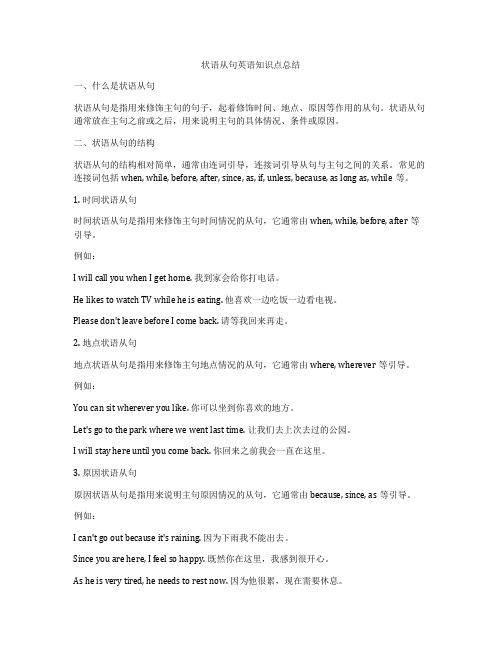
状语从句英语知识点总结一、什么是状语从句状语从句是指用来修饰主句的句子,起着修饰时间、地点、原因等作用的从句。
状语从句通常放在主句之前或之后,用来说明主句的具体情况、条件或原因。
二、状语从句的结构状语从句的结构相对简单,通常由连词引导,连接词引导从句与主句之间的关系。
常见的连接词包括when, while, before, after, since, as, if, unless, because, as long as, while等。
1. 时间状语从句时间状语从句是指用来修饰主句时间情况的从句,它通常由when, while, before, after等引导。
例如:I will call you when I get home. 我到家会给你打电话。
He likes to watch TV while he is eating. 他喜欢一边吃饭一边看电视。
Please don't leave before I come back. 请等我回来再走。
2. 地点状语从句地点状语从句是指用来修饰主句地点情况的从句,它通常由where, wherever等引导。
例如:You can sit wherever you like. 你可以坐到你喜欢的地方。
Let's go to the park where we went last time. 让我们去上次去过的公园。
I will stay here until you come back. 你回来之前我会一直在这里。
3. 原因状语从句原因状语从句是指用来说明主句原因情况的从句,它通常由because, since, as等引导。
例如:I can't go out because it's raining. 因为下雨我不能出去。
Since you are here, I feel so happy. 既然你在这里,我感到很开心。
中考英语《状语从句》知识总结:定语从句与状语从句
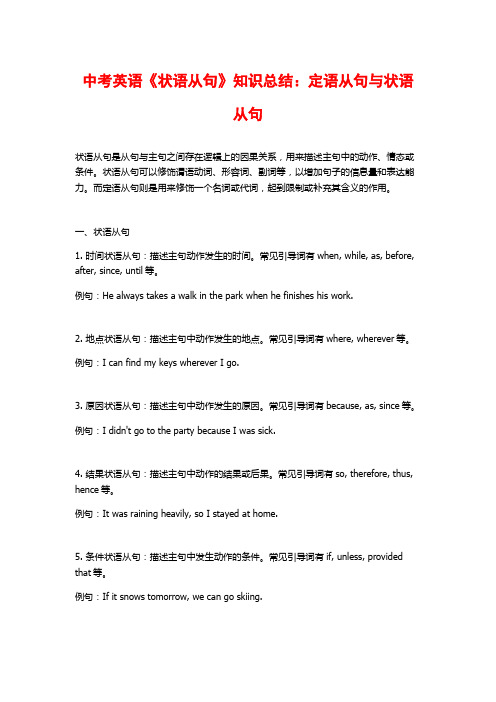
中考英语《状语从句》知识总结:定语从句与状语从句状语从句是从句与主句之间存在逻辑上的因果关系,用来描述主句中的动作、情态或条件。
状语从句可以修饰谓语动词、形容词、副词等,以增加句子的信息量和表达能力。
而定语从句则是用来修饰一个名词或代词,起到限制或补充其含义的作用。
一、状语从句1. 时间状语从句:描述主句动作发生的时间。
常见引导词有when, while, as, before, after, since, until等。
例句:He always takes a walk in the park when he finishes his work.2. 地点状语从句:描述主句中动作发生的地点。
常见引导词有where, wherever等。
例句:I can find my keys wherever I go.3. 原因状语从句:描述主句中动作发生的原因。
常见引导词有because, as, since等。
例句:I didn't go to the party because I was sick.4. 结果状语从句:描述主句中动作的结果或后果。
常见引导词有so, therefore, thus, hence等。
例句:It was raining heavily, so I stayed at home.5. 条件状语从句:描述主句中发生动作的条件。
常见引导词有if, unless, provided that等。
例句:If it snows tomorrow, we can go skiing.6. 目的状语从句:描述主句中动作的目的。
常见引导词有in order that, so that等。
例句:I'm taking extra English classes so that I can improve my speaking skills.7. 方式状语从句:描述主句中动作的方式或方法。
【初中英语】初中英语语法对方式状语从句的总结
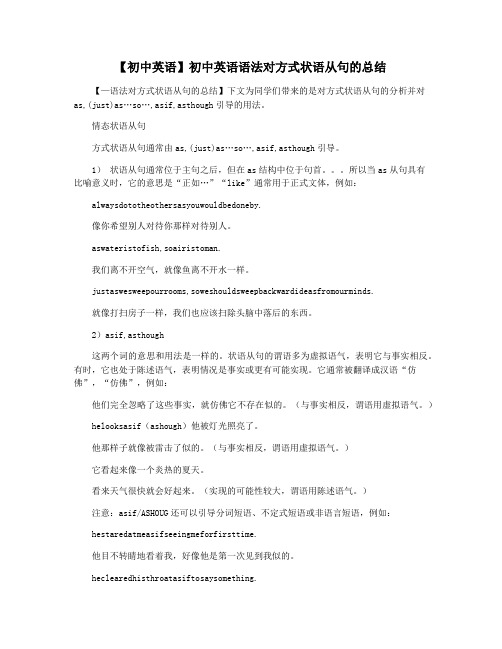
【初中英语】初中英语语法对方式状语从句的总结【—语法对方式状语从句的总结】下文为同学们带来的是对方式状语从句的分析并对as,(just)as…so…,asif,asthough引导的用法。
情态状语从句方式状语从句通常由as,(just)as…so…,asif,asthough引导。
1)状语从句通常位于主句之后,但在as结构中位于句首。
所以当as从句具有比喻意义时,它的意思是“正如…”“like”通常用于正式文体,例如:alwaysdototheothersasyouwouldbedoneby.像你希望别人对待你那样对待别人。
aswateristofish,soairistoman.我们离不开空气,就像鱼离不开水一样。
justaswesweepourrooms,soweshouldsweepbackwardideasfromourminds.就像打扫房子一样,我们也应该扫除头脑中落后的东西。
2)asif,asthough这两个词的意思和用法是一样的。
状语从句的谓语多为虚拟语气,表明它与事实相反。
有时,它也处于陈述语气,表明情况是事实或更有可能实现。
它通常被翻译成汉语“仿佛”,“仿佛”,例如:他们完全忽略了这些事实,就仿佛它不存在似的。
(与事实相反,谓语用虚拟语气。
) helooksasif(ashough)他被灯光照亮了。
他那样子就像被雷击了似的。
(与事实相反,谓语用虚拟语气。
)它看起来像一个炎热的夏天。
看来天气很快就会好起来。
(实现的可能性较大,谓语用陈述语气。
)注意:asif/ASHOUG还可以引导分词短语、不定式短语或非语言短语,例如:hestaredatmeasifseeingmeforfirsttime.他目不转睛地看着我,好像他是第一次见到我似的。
heclearedhisthroatasiftosaysomething.他清了清嗓子,好像要说什么似的。
thewavesdashedontherocksasifinanger.海浪拍打着岩石,仿佛怒不可遏。
- 1、下载文档前请自行甄别文档内容的完整性,平台不提供额外的编辑、内容补充、找答案等附加服务。
- 2、"仅部分预览"的文档,不可在线预览部分如存在完整性等问题,可反馈申请退款(可完整预览的文档不适用该条件!)。
- 3、如文档侵犯您的权益,请联系客服反馈,我们会尽快为您处理(人工客服工作时间:9:00-18:30)。
初中英语语法--- 状语从句小结状语从句是一种作状语用的从句,修饰主句的动词、形容词、副词或修饰全句,补充说明时间、地点、原因、条件、方式、程度、状态等。
根据它表达的意思的不同,可分为时间状语从句、地点状语从句、原因状语从句、条件状语从句、比较状语从句、目的状语从句、结果状语从句等。
时间状语从句、条件状语从句、结果状语从句、原因状语从句都是中考的重点。
一、时间状语从句时间状语从句表示主句动作发生的时间,引导时间状语从句的连词有when, as, while, before, after, as soon as, till, until, sinc等。
until 用于肯定句中,表示句子的动作一直持续到until 短语所表示的时间为止,即表示动作的终点。
一般可译为直到……时(为止)'或在……以前”在这种用法中,句子的谓语动词必须是持续动词(非瞬间动词),女口live, wait, last, love, like, stay, work, continue等。
until 用于否定句中,表示句子的动作直到until 短语所表示的时间才开始发生,即表示动作的起点。
一般译为直到……才”或直到……之前(……还不)”eg. It may last until Friday. 这可能要延续到星期五。
用于否定句中:eg. The secret was never told until after the old man's death.这个秘密在老人去世后才说出来。
连词until以同样的方式分析作连词的until 的用法。
作连词用的until 的英文释义是up to the time whe n(直到............. 时为止)。
作连词的until 用于肯定句中,表示主句的动作一直持续到从句动作发生或状态出现时为止。
一般可译为“••…直到……为止”在这种用法中,主句的谓语动词必须是持续动词(非瞬间动词),如live, wait , last, love, like, stay, work, continue 等。
eg. Heat can be conducted from a hot body to a cooler one until both are at the same temperature.热可以从一个热的物体传到一个较冷的物体,直到两者温度相同为止。
作连词的until 用于否定句中, 表示主句的动作在从句的动作发生之前尚未发生,或者说主句的动作在从句的动作发生之后才开始。
一般可译为“直到……才”。
eg. I hadn't realized she was foreign until she spoke. 她不说话我还一直不知道她是个外国人。
si nee作连词引导时间状语从句的用法:一、若since 引导的状语从句的谓语动词是终止性的过去时,则从句表示的时间是“从动作开始的那一时刻起”。
如:eg. He has studied very hard since he came to our school. 自从他来到我们学校,他学习就非常努力。
二、若since引导的状语从句的谓语动词是持续性动词或表示状态的动词的过去时时,则从句表示的时间是“从那持续动作或状态结束时算起”。
eg. I haven't heard any noise since I slept.Sleep为持续性动词,sleep的动作结束时,即醒来”时,这句应译为我醒后还未听到任何声音”。
John is now with his parents in New York, it is already three years since he was a teacher. 约翰现在和父母一起住在纽约,他不当教师已经三年了。
while表示正当…… 时”(指同时)用于同时进行的两延续性动作相伴随而发生,常对同类的两动作进行对比。
eg. Please write while I read. 我念的时候,请写下来。
when 表示“当……. 时:可表示瞬间、时间段,与主从句所述动作、事情可同时,也可有先后。
例:eg. It was snowing when we got to the airport. 我们到达机场时,天正下着雪。
(同时发生)。
as 当…时,强调at the same time①不指先后,而指同时发生,尤指短动作或事件同时发生,eg. I looked; some one came here正当我看的时候,有个人走过来。
②as不可说明两种正在发展或变化的情况。
eg. As I get older, I get more optimistic. 随着年龄变大我变得更加乐观。
as、when、while 都可引导时间较长的同时发生的“背景”情况。
eg. As (when, while) I was walking down the street, I noticed a police car in front of a shop.当我顺着马路往前走的时候,我发现一家商店前停着一辆警车。
注意:1.在以as soon as, until, when等引导的时间状语从句中,通常用一般现在时,而主句用将来时。
2. since引导的时间状语从句用一般过去时,主句常用完成时,并且动词用延续性动词。
二、条件状语从句条件状语从句表示主句动作发出的前提或条件、假想、推测等,条件状语从句通常由连词if, uni ess等引导。
eg. I'll help you with your English if I am free tomorrow. 如果我明天有空,我就帮你学英语。
He won't be late unless he is ill. 他不会迟到的,除非他生病了。
注意:在if, uni ess等词引导的条件状语从句,主句的谓语动词用一般将来时,从句的谓语动词通常用一般现在时表示将来的含义。
三、目的状语从句目的状语从句表示主句的动作发生的目的或愿望,可用so that, that,in order that等词引导。
目的状语动词中常有情态动词may/might, can/could, should或will/would.eg. He visited London in order that he could see his parents.=He visited London so that he could see his pare nts 为了看望父母他来到了伦敦。
School was closed early in order that the childre n might get home ahead of the storm .学校早放学,为的是让孩子们在暴风雨前到家。
四、结果状语从句结果状语从句表示主句的动作所引起的结果,可以用so…that,such …that等引导。
eg. The burglar wore gloves, so that there were no fin gerpri nts found 窃贼带着手套,所以没有发现指纹。
He spoke so quickly that only a few students could follow him. 他讲话太快,只有几个学生能听懂。
The house is so expensive that very few people can afford it. 房子价格太贵,很少有人买得起。
He was so good a runner that no body could catch him他是跑步的能手,没人能赶上他。
It is such a good cha nee that we must n't miss it.如此好的机会我们绝不能错过。
It is such nice weather that I don't like to stay at home.天气这么好,我不愿呆在家里。
辨析:so…that和such…thatso…that和such…that的意思均为如此... 以致.... ”,都用来引导结果状语从句。
但二者用法不尽相同,现归纳如下:1. so…that结构中的so为副词,后面跟形容词或副词;such…that中的such为形容词,后面接名词(名词前可以有形容词修饰)。
eg. He became so angry that he could n't speak .他变得很生气,以致说不出话来。
It was such a fine day that we went out for a walk. 那是一个很晴朗的日子,我们出去散步。
2. 当that前的名词有表示数量多少的many, much, few, little等修饰时,只能用so,不能用such.eg. There was so much noise outside that we couldn't hear the teacher. 外面嘈杂声很大,以致我们不能听到老师的话。
He had so many falls that he was black and blue all over.他跌了这么多的跤,以致全身青一块、紫一块的。
注意:若名词前的little 解释为“小(的)”意思时,则仍用such, 而不能用so.eg. They are such little sheep that they can't run fast. 它们是小绵羊,以至于它们跑得不快。
3. 当that前是单数可数名词且该名词前面有形容词修饰时,so与such可以互换,即:so+ adj.+ a/an+ n. = such+ a/an+ adj.+ n.eg.She is so good a teacher that we all love her.= She is such a good teacher that we all love her她是一位好老师,我们都爱她。
4. 当that前是不可数名词或复数可数名词时,则必须用such,不能用so来代替。
eg. It was such fine weather that they all went swimming. 那是个好天气,他们都去游泳了。
They are such nice apples that we would like to eat the m 它们是如此好的苹果,以致我们想吃它们。
五、原因状语从句原因状语从句由because, as, for, sine等引导。
